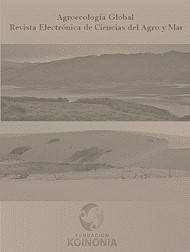Obtaining a mixture of salts for the salting process of chigüire meat
DOI:
https://doi.org/10.35381/a.g.v4i6.1672Keywords:
Optimization, veterinary, food control. (UNESCO Thesaurus).Abstract
The general objective of the research was to obtain a mixture of salts for the salting process of chigüire (Hydrochoerus hydrochaeris) meat, which was developed in different phases, such as: the physicochemical and bacteriological characterization of the chigüire meat, before and after applying the salting process in dry pile, with NaCl, KCl, CaCl2 and MgCl2. Also, the evaluation of the chemical and bacteriological stability of the meat salted with different proportions of KCl, CaCl2 and MgCl2, with respect to that salted with NaCl; and the sensory evaluation of the chigüire meat after having applied the salting process. The partial substitution of NaCl by KCl, CaCl2 and MgCl2 caused significant effects in the sensory analysis of salted chigüire meat, since the attributes: color, odor, flavor, texture and appearance, had a general acceptance. The physicochemical and microbiological parameters should be established.
Downloads
References
Aliño, M., Grau, R., Baigts, D. y Barat, J. (2009). Influence of sodium replacement on the salting kinetics of pork loin. J Food Eng. 97, 434-439.
Andrés, A., Cava, R., Ventanas, J., Thovar, V. y Ruiz, J. (2001). Sensory characteristics of Iberian ham: Influence of salt content and processing conditions. MeatScience, Volumen 68; 15-51.
Armenteros, M. (2010). Reducción de sodio en lomo y jamón curados. Efecto sobre la proteólisis y las características sensoriales [Reduction of sodium in cured loin and ham. Effect on proteolysis and sensory characteristics]. Departamento de Tecnología de Alimentos. Consejo Superior de Investigaciones Científicas. Instituto de Agroquímica y Tecnología de Alimentos. Universidad Politécnica de Valencia. Valencia. España. Recuperado de: https://n9.cl/hai4a
Arnau, J., Maneja, E., Gou, P., Guerrero, L., Casademont, G. y Gelabert, J. (1995). Disminución del contenido de sodio en productos cárnicos crudos curados. [Decreased sodium content in cured raw meat products] Proyecto N° SC 93-126. Centro de Tecnología de la Carne “Granja Camps i Armet”. Monells, Girona. Recuperado de: www.inia.es/gcontrec/ Proyectos/Resultados/sc93-126.pdf
Dunajski. (1979). Striped Bass and Other Morone Culture. Developments in Aquaculture and Fisheries Science.Volumen 30. Editorial R.M. Harrell, 264-270. Recuperado de: https://n9.cl/x5sq0
Ferrandino. S. (2016). What are the benefits of potassium chloride? Jillian Michaels. Recuperado de: https://n9.cl/uym41
Flórez, K. (2015). Las increíbles propiedades del cloruro de magnesio para la salud del cuerpo. Mejor con salud. Recuperado de: https://n9.cl/w8drf
Giraldo, D. (2002). Importancia de la Fauna Silvestre en el Neotrópico. Caso de Estudio: El Chigüire en Venezuela. [Importance of Wildlife in the Neotropics. Case Study: The Chigüire in Venezuela] Trabajo presentado en el XI Congreso Venezolano de Producción e Industria Animal. Universidad de Los Andes. Edo. Trujillo. Venezuela.
González, V. (2010). Evaluación de la sustitución de NaCl en el proceso de salado de carne caprina (Caprahircus) [Evaluation of naCl substitution in the salting process of goat meat (Caprahircus)]. Trabajo Especial de Grado. Universidad Nacional Experimental Francisco de Miranda. Punto Fijo. Edo. Falcón. Venezuela.
Gutiérrez, S. (2012). El chigüire. Un gigante entre los roedores. [The chigüire. A giant among rodents]. Revista Río Verde. Caracas. 7,101-109.
Hernández, R., Fernández, C. y Baptista P. (2014). Metodología de la Investigación. [Research Methodology] Editorial Mc Graw Hill Education. Sexta edición. México.
Kurlanski, M. (2002). Salt. A World History. London: Random House.
Ordóñez, J., Cambero, M., Fernández, L., García, M., De Fernando, G., De la Hoz, L., y Selgas, M. (1998). Tecnología de los Alimentos. Alimentos de origen animal. [Food Technology. Food of animal origin] 2. Editorial Síntesis. Madrid, España. 360p.Recuperado de: https://n9.cl/5iocl
Ranganna, S. (1977). Manual of Analysis of Fruits and Vegetable Products.Editorial McGraw-Hill. Recuperado de: https://n9.cl/y92fy
Reddy, K. y Marth, E. (1991). Reducing the Sodium Content in Foods: Areview.Journal of FoodProtection, 54, (2), 138-150.
Sarango, V. (2011). Manual para manejo de capibaras (Hidrochaeris hidrochaeris). Capacitación, diseño y asesoría técnica para la implementación de zoocriaderos productivos en la comuna Indillama en la cuenca media baja del río Napo. [Manual for handling capybaras (Hidrochaeris hidrochaeris). Training, design and technical advice for the implementation of productive zoos in the Indillama commune in the lower middle basin of the Napo River] Ministerio de Ambiente. Quito, Ecuador.
Soto, I. (2012). MSC Noticias. Es preciso que el venezolano reduzca cuanto antes el consumo de sal [MSC News. It is necessary that the Venezuelan reduce as soon as possible the consumption of sal]. Recuperado de: https://n9.cl/fa2s7
Valls J., Paredes A., González D. y González, A. (2006). Evaluación física, química, microbiológica y sensorial de filetes de sardina (Sardinilla aurita v.) empacados al vacío y congelados a -18°C. [Physical, chemical, microbiological and sensory evaluation of sardine fillets (Sardinilla aurita v.) vacuum-packed and frozen at -18°C] Fundación La Salle de Ciencias Naturales. Estación de Investigaciones Marinas de Margarita, EDIMAR.
Velasco B., Roldan De Sola, A. y Marín, E. (2008). El chigüire en Venezuela (Hydrochaerushydrochaeris) y su plan de manejo [The chigüire in Venezuela (Hydrochaerushydrochaeris) and its management plan]. Memoria de la Fundación La Salle de Ciencias Naturales. Caracas. 169; 107-122.
Weineck, J. (2001). Salud, Ejercicio y Deporte [Health, Exercise and Sport]. Editorial Paidotribo. Barcelona. España.
Published
How to Cite
Issue
Section
License
CC BY-NC-SA : Esta licencia permite a los reutilizadores distribuir, remezclar, adaptar y construir sobre el material en cualquier medio o formato solo con fines no comerciales, y solo siempre y cuando se dé la atribución al creador. Si remezcla, adapta o construye sobre el material, debe licenciar el material modificado bajo términos idénticos.
OAI-PMH URL: https://fundacionkoinonia.com.ve/ojs/index.php/agroecologiaglobal/oai





.png)


